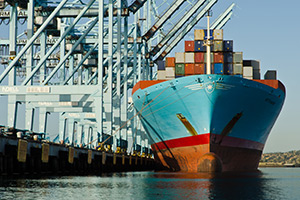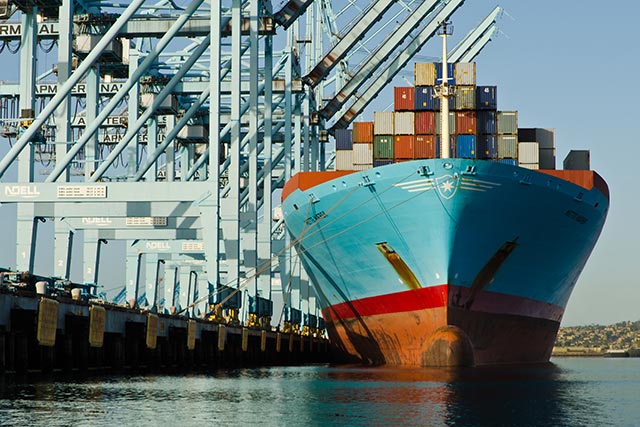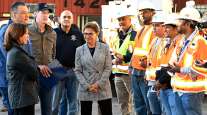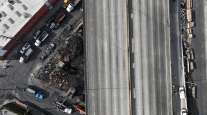Port of L.A. Rolled Back Measures to Cut Pollution During Its 'Green' Expansion

 Lance M. Cunningham/Flickr
Lance M. Cunningham/FlickrShortly after the Port of Los Angeles agreed to require air quality improvements at one of its busiest terminals seven years ago, top port officials privately began rolling back pollution-cutting measures they promised, government records obtained by The Los Angeles Times show.
The city-owned port gave China Shipping North America permission to ignore some of the emissions-reduction requirements the city agreed to impose as part of a highly publicized legal settlement with environmentalists and homeowners near the complex.
As a condition of allowing the company to expand its terminal in 2008, the port pledged to transform it into a "green" operation through a series of measures to reduce harmful emissions from diesel trucks, container ships and cargo-handling equipment.
In September, the port disclosed that it has failed to carry out several requirements.
Port records obtained by The Times under the California Public Records Act show that just a few months after the city approved the expansion, Geraldine Knatz, executive director of the port at the time, assured China Shipping that it would face no consequences for violating a major requirement: Instead of idling diesel-powered engines while docked, at least 70% of its ships would have to plug into shore-based electricity, known as Alternative Maritime Power.
"The Port will not hold China Shipping responsible for any outcome as a result of not meeting the 70% AMP requirement," Knatz wrote in an April 2009 letter to the company.
Subsequent letters from Knatz show the port formally waived the shore power rules as they became more stringent in 2011. The port extended the waivers until state regulators began requiring the practice in 2014.
The letters and other documents show that top officials at the port were for years aware of the shortcomings at the 130-acre terminal near the Vincent Thomas Bridge and leased to China Shipping.
Staff members kept track as the company violated a series of mandates to deploy cleaner natural-gas fueled trucks, less-polluting yard equipment and to slow down ships as they approach to cut emissions of diesel particulate matter, a carcinogen, and other lung-damaging pollutants.
Port employees also tallied the tens of millions of dollars it would cost the company to fully comply.
China Shipping did not respond to calls seeking comment.
Environmentalists and harbor-area homeowners who won a legal battle that forced the port to clean up operations at the terminal say people have been subjected to years of excess air pollution and irreversible health damage as a result of the unmet requirements. They were dismayed to learn of the waivers.
"To find out after the fact, many years later, that your win has been taken away behind closed doors is very frustrating," said Kathleen Woodfield, vice president of the San Pedro & Peninsula Homeowners Coalition, one of the plaintiffs in the lawsuit against the port that was settled in 2004.
Port emissions increase cancer risk and asthma rates in nearby communities and contribute to poor air quality across the Los Angeles Basin, according to health studies and pollution regulators. Statewide, ocean vessels release nearly twice the amount of smog-forming nitrogen oxides as all the passenger vehicles in California, according to state emissions inventories.
Each cargo ship that plugs into electrical power while in port prevents the release of about one ton of nitrogen oxides and 40 pounds of diesel particulate matter per visit, according to a 2007 analysis by the California Air Resources Board.
Port officials say that despite the unfulfilled measures, emissions at the China Shipping terminal were at or below levels predicted when the city approved the project in 2008.
While lower-than-expected cargo volumes played a role in those reductions, officials credit their Clean Truck Program and other voluntary initiatives with slashing emissions throughout the L.A.-Long Beach port complex over the last decade.
Gene Seroka, a former shipping industry executive Los Angeles Mayor Eric Garcetti hired last year as head of the port, has vowed to fix the problems at the China Shipping terminal, which he has blamed on previous administrators.
"I am fully committed to compliance and transparent governance and oversight with respect to all of the port's business," Seroka said in a written statement.
The port has tried and so far failed to revise its long-term lease with China Shipping to include the required measures. Officials said their negotiations with the company continue.
Knatz said she granted the waivers because then-Mayor Antonio Villaraigosa, who hired her in 2006, "wanted us to be flexible" during the sharp economic downturn after the recession that began in 2007.
The mayor's office gave no specific instructions regarding China Shipping, Knatz said, but provided "a general direction to be helpful to the customers and help them ride this out."
Cargo volumes at the nation's busiest port complex — a major economic engine — had dropped considerably, Knatz said. Ocean carriers shifted to smaller, older ships that were not equipped to connect to shore-side power.
"China Shipping came to the port and said they had a compliance problem," Knatz said. Port staff verified that emissions at the terminal were below required levels before issuing the waivers, she added.
"During the downturn I could not even walk around San Pedro without women coming up to me asking me when their husbands were going to be able to work," Knatz said. "As long as [China Shipping] met their emissions level we were not going to turn ships away."
Villaraigosa said he did not recall any conversations with port staff about waivers "generally or specifically with China Shipping," and that neither did several former deputies and advisers he queried.
Villaraigosa said his efforts as mayor "were all focused around greening the port, not the other way around."
After the port waived the shore power requirements for China Shipping, the%age of vessels plugging into electricity at the terminal declined to 12% in 2012 from 66% in 2011, records show. Compliance increased to 98% in 2014 as the state requirements kicked in.
Port spokesman Arley Baker said that when the port issued the waivers, "China Shipping committed to bringing more ships into service that would be able to power at berth — and over time they did."
Port records also show how far behind China Shipping has fallen in meeting another obligation that it rely on lower-polluting trucks to transport goods to and from the terminal. Instead of sharply increasing transport by liquefied natural gas-fueled trucks to 70% as required, use of those vehicles declined to 6% last year.
The Times requested copies of compliance reports that China Shipping is required to submit periodically and annual reports the port must make available to the public as a condition of the terminal expansion.
The city's response said "such documents do not exist."
When the port disclosed the problems three months ago, officials began a new environmental review that will look at eliminating, revising or replacing some of the unmet pollution-reduction measures they have described as "infeasible."
The port is also doing an internal review of another terminal, operated by TraPac, for which the city in 2007 approved an expansion with similar provisions to reduce air pollution.
L.A. City Council members Bob Blumenfield, Paul Koretz and Joe Buscaino have summoned port officials to a committee hearing on Tuesday to report on steps they are taking to remedy the situation.
Community groups, furious over the unfulfilled promises, have called for the appointment of a third party to oversee the port's progress in carrying out emissions-reduction measures. They have also demanded the port account for how much extra pollution was released and analyze the health effects.
Homeowners and advocacy groups have considerable leverage under the $50-million legal settlement, signed in 2004, because they could sue the port at any time for failing to live up to the agreement.
Those groups are waiting to hear officials' plans. Their attorneys said they expect the port to move quickly to replace cargo-handling equipment with cleaner, zero-emissions technology and to incorporate aggressive new pollution-cutting measures into a new lease with China Shipping.
"We are all hoping that the port steps up and does the right thing," said Morgan Wyenn, an attorney for the Natural Resources Defense Council, which brought the lawsuit against the city over the terminal expansion on behalf of residents and community groups.
Reducing emissions from the ports in Los Angeles and Long Beach is critical to cleaning the region's air because they are the largest single pollution source in Southern California.
The South Coast Air Quality Management District has asked the Port of L.A. to study whether its failure to meet its commitments at the China Shipping terminal will hinder plans for cleaning smog to meet federal health standards.
The ports of L.A. and Long Beach have fought a rule proposed years ago by the air district that would hold them accountable for other pledges made in their 2006 Clean Air Action Plan. Air quality officials have not acted on the proposal.




